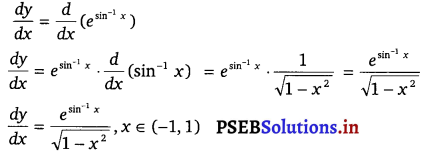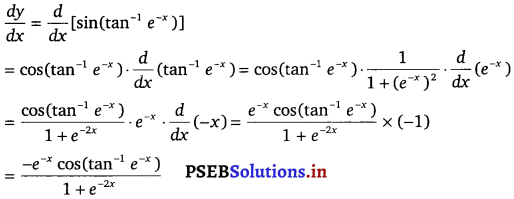Punjab State Board PSEB 12th Class Maths Book Solutions Chapter 5 Continuity and Differentiability Ex 5.4 Textook Exercise Questions and Answers.
PSEB Solutions for Class 12 Maths Chapter 5 Continuity and Differentiability Ex 5.4
Question 1.
\(\frac{e^{x}}{\sin x}\)
Solution.
Let y = \(\frac{e^{x}}{\sin x}\)
By using the quotient rule, we get
\(\frac{d y}{d x}\) = \(\frac{\sin x \frac{d}{d x}\left(e^{x}\right)-e^{x} \frac{d}{d x}(\sin x)}{\sin ^{2} x}\)
= \(\frac{\sin x \cdot\left(e^{x}\right)-e^{x} \cdot(\cos x)}{\sin ^{2} x}\)
= \(\frac{e^{x}(\sin x-\cos x)}{\sin ^{2} x}\), x ≠ nπ, n ∈ Z.
![]()
Question 2.
esin-1 x.
Solution.
Let y = esin-1 x
By using the chain rule, we get

Question 3.
ex3
Solution.
Let y = ex3
By using the chain rule, we get
\(\frac{d y}{d x}\) = \(\frac{d}{d x}\) (ex3)
= ex3 . \(\frac{d}{d x}\) (x3)
= ex3 . 3x2
= 3x2 ex3
![]()
Question 4.
sin(tan-1 e-x
Solution.
Let y = sin(tan-1 e-x
By using the chain rule, we get

Question 5.
log (cos ex)
Solution.
Let y = log (cos ex)
By using the chain rule, we get
\(\frac{d y}{d x}\) = \(\frac{d}{d x}\) [log (cos ex)]
= \(\frac{1}{\cos e^{x}}\) . \(\frac{d}{d x}\) (cos ex)
= \(\frac{1}{\cos e^{x}}\) . (- sin ex) . \(\frac{d}{d x}\) (ex)
= \(\frac{-\sin e^{x}}{\cos e^{x}}\) . ex
= – ex tan ex, ex ≠ (2n + 1) \(\frac{\pi}{2}\), n ∈ N.
![]()
Question 6.
\(e^{x}+e^{x^{2}}+\ldots+e^{x^{5}}\)
Solution.
\(e^{x}+e^{x^{2}}+\ldots+e^{x^{5}}\)
By using the chain rule, we get
\(\frac{d y}{d x}\) = \(\frac{d}{d x}\) (\(e^{x}+e^{x^{2}}+\ldots+e^{x^{5}}\))
= \(\frac{d}{d x}\) (ex ) + \(\frac{d}{d x}\) (ex2) + \(\frac{d}{d x}\) (ex3) + \(\frac{d}{d x}\) (ex4) + \(\frac{d}{d x}\) (ex5)
= ex + [ex2 . \(\frac{d}{d x}\) (x2)] + [ ex3 . \(\frac{d}{d x}\) (x3)] + [ex4 . \(\frac{d}{d x}\) (x4)] + [ex5 . \(\frac{d}{d x}\) (x5)]
= ex + (ex2 × 2x) + (ex3 × 3x2) + (ex4 × 4x3) + (ex5 × 5x4)
= ex + 2x ex2 + 3x2 ex3 + 4x3 ex4 + 5x4 ex5
![]()
Question 7.
\(\sqrt{e^{\sqrt{x}}}\), x > 0
Solution.
Let y = \(\sqrt{e^{\sqrt{x}}}\)
Then, y2 = e√x
On differentiating w.r.t x, we get
y2 = e√x
⇒ 2y \(\frac{d y}{d x}\) = e√x (√x)
⇒ 2y \(\frac{d y}{d x}\) = e√x \(\frac{1}{2} \cdot \frac{1}{\sqrt{x}}\)
⇒ \(\frac{d y}{d x}=\frac{e^{\sqrt{x}}}{4 y \sqrt{x}}\)
⇒ \(\frac{d y}{d x}=\frac{e^{\sqrt{x}}}{4 \sqrt{e^{\sqrt{x}}} \sqrt{x}}\)
⇒ \(\frac{d y}{d x}=\frac{e^{\sqrt{x}}}{4 \sqrt{x e^{\sqrt{x}}}}\), x > 0
Question 8.
log (log x), x > 1
Solution.
Let y = log (log x)
By using the chain rule, we get
\(\frac{d y}{d x}\) = \(\frac{d}{d x}\) [log (log x)]
= \(\frac{1}{\log x} \cdot \frac{d}{d x}\) (log x)
= \(\frac{1}{\log x} \cdot \frac{1}{x}=\frac{1}{x \log x}\), x > 1.
![]()
Question 9.
\(\frac{\cos x}{\log x}\), x > 0
Solution.
Let y = \(\frac{\cos x}{\log x}\)
By using quotient rule, we get
\(\frac{d y}{d x}=\frac{\frac{d}{d x}(\cos x) \times \log x-\cos x \times \frac{d}{d x}(\log x)}{(\log x)^{2}}\)
= \(\frac{-\sin x \log x-\cos x \times \frac{1}{x}}{(\log x)^{2}}\)
= \(\frac{-[x \log x \sin x+\cos x]}{x(\log x)^{2}}\), x > 0.
![]()
Question 10.
cos (log x + ex), x > 0
Solution.
Let y = cos (log x + ex)
By using chain rule, we get
\(\frac{d y}{d x}\) = – sin (log x + ex) + \(\frac{d}{d x}\) (log x + ex)
= – sin (log x + ex) . [\(\frac{d}{d x}\) (log x) + \(\frac{d}{d x}\) (ex)]
= – sin (log x + ex) . (\(\frac{1}{x}\) + ex)
= – (\(\frac{1}{x}\) + ex) sin (log x + ex).
